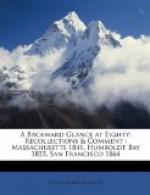I shall feel that I am derelict if I do not manage a jaunt to the Cliff House. The most desirable method demands a span of horses for a spin out Point Lobos Avenue. We may, however, be obliged to take a McGinn bus that leaves the Plaza hourly. It will be all the same when we reach the Cliff and gaze on Ben Butler and his companion sea-lions as they disport themselves in the ocean or climb the rocks. Wind or fog may greet us, but the indifferent monsters roar, fight, and play, while the restless waves roll in. We must, also, make a special trip to Rincon Hill and South Park to see how and where our magnates dwell. The 600 block in Folsom Street must not be neglected. The residences of such men as John Parrott and Milton S. Latham are almost palatial. It is related that a visitor impressed with the elegance of one of these places asked a modest man in the neighborhood if he knew whose it was. “Yes,” he replied, “it belongs to an old fool by the name of John Parrott, and I am he.”
We shall leave out something distinctive if we do not call at the What Cheer House in Sacramento Street below Montgomery, a hostelry for men, with moderate prices, notwithstanding many unusual privileges. It has a large reading-room and a library of five thousand volumes, besides a very respectable museum. Guests are supplied with all facilities for blacking their own boots, and are made at home in every way. Incidentally the proprietor made a good fortune, a large part of which he invested in turning his home at Fourteenth and Mission streets into a pleasure resort known as Woodward’s Gardens, which for many years was our principal park, art gallery and museum.
These are a few of the things I could have shown. But to know and appreciate the spirit and character of a city one must live in it and be of it; so I beg to be dismissed as a guide and to offer experiences and events that may throw some light on life in the stirring sixties.
When I migrated from Humboldt County and enlisted for life as a San Franciscan I lived with my father’s family in a small brick house in Powell Street near Ellis. The Golden West Hotel now covers the lot. The little houses opposite were on a higher level and were surrounded by small gardens. Both street and sidewalks were planked, but I remember that my brother and I, that we might escape the drifting sand, often walked on the flat board that capped the flimsy fence in front of a vacant lot. On the west of Powell, at Market, was St. Ann’s Garden and Nursery. On the east, where the Flood Building stands, was a stable and riding-school.
Much had been accomplished in city building, but the process was continuing. Few of us realize the obstacles overcome. Fifteen years before, the site was the rugged end of a narrow peninsula, with high rock hills, wastes of drifting sand, a curving cove of beach, bordered with swamps and estuaries, and here and there a few oases in the form of small valleys. In 1864 the general lines of the city were practically those of today. It was the present San Francisco, laid out but not filled out. There was little west of Larkin Street and quite a gap between the city proper and the Mission.




